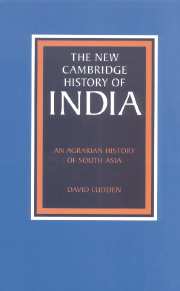4 - Modernity
Published online by Cambridge University Press: 28 March 2008
Summary
In the nineteenth century, industrial empire brought new force into the transformation of agrarian regions. Britain controlled the corridors of mobility in southern Eurasia. English became the imperial language. A new rupee homogenised the money supply.
In 1800, cowry shells from the Andamans were the currency in Sylhet, and dozens of different silver, gold, and copper coins filled markets from Surat to Chittagong. Money changers worked every corner. But in the 1820s, the Company’s silver rupee set the monetary standard and market prices began a tumble that lasted thirty years. In these hard decades, markets contracted along routes of imperial expansion, real taxation increased, seasons of scarcity were common, and overseas cloth exports died. The Act of 1793 had established a permanent settlement with no survey, no records of rights, and no definite method of assessment; after 1820, zamindari settlements required the recording of rights, annual assessments of cultivated land, and periodic reassessments. Almost everywhere, routine revenue collections provoked struggles and dislocations. When indigo stocks crashed on the London exchange, Bihari peasants lost their income and tenants lost their land. The Torture Commission in Madras reported routine beatings by revenue officers. Company critics multiplied in London but could not quite topple the old regime before rebellions killed the Company in 1857. Crown rule ended an imperial crisis. Prices had begun moving upward again by 1855, and decades of inflation then steadily lowered the real cash burden of revenue and rent. Land became more attractive for investors as a veneer of modernity covered British India.
- Type
- Chapter
- Information
- An Agrarian History of South Asia , pp. 167 - 230Publisher: Cambridge University PressPrint publication year: 1999



